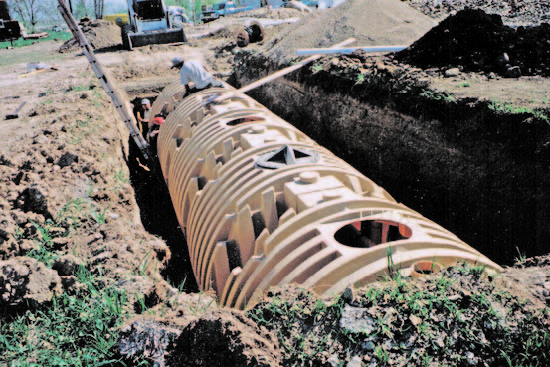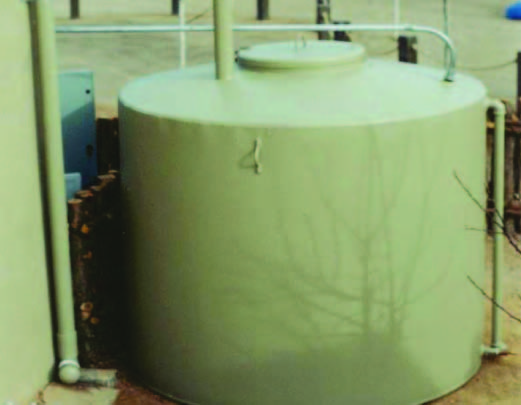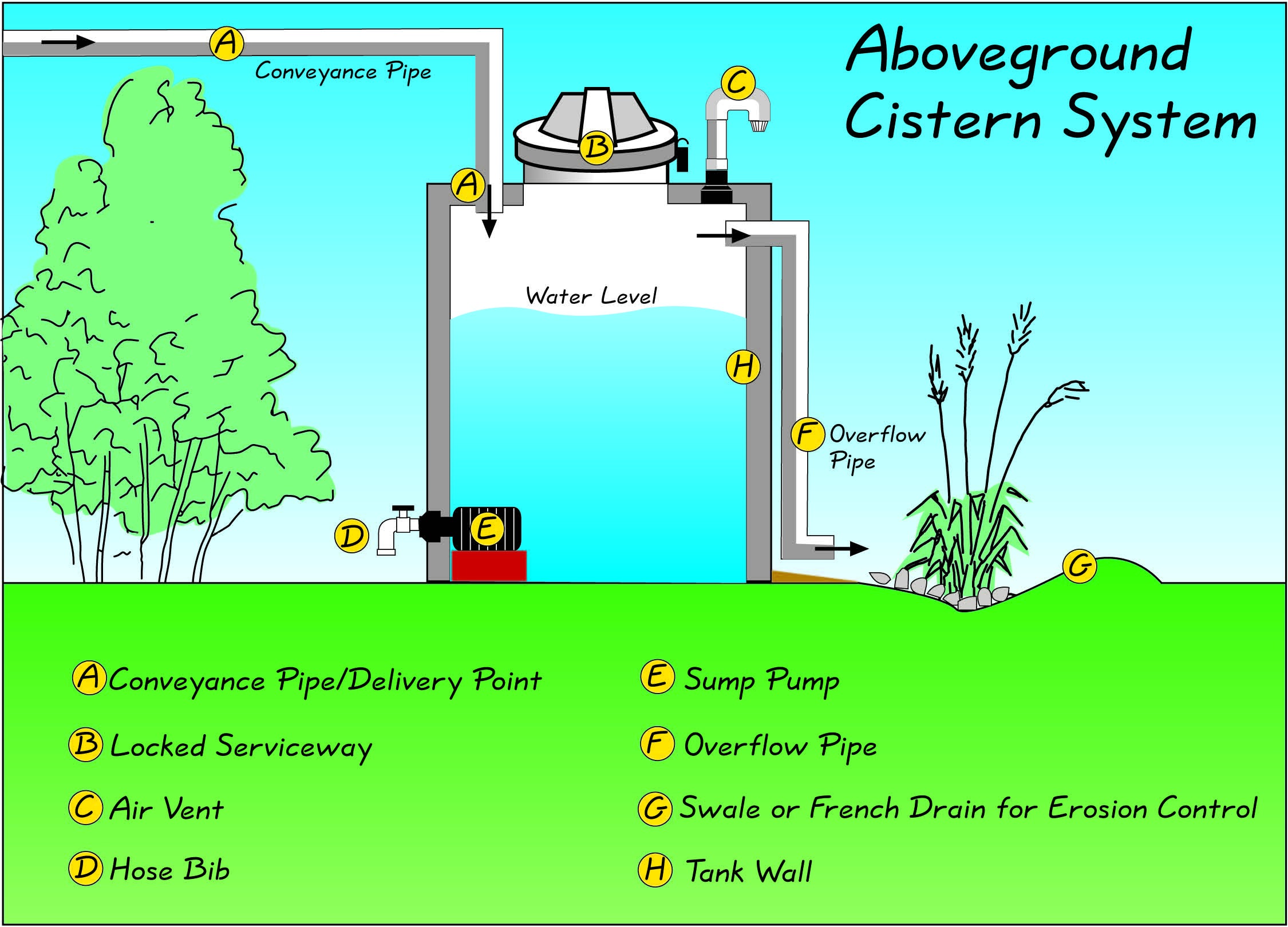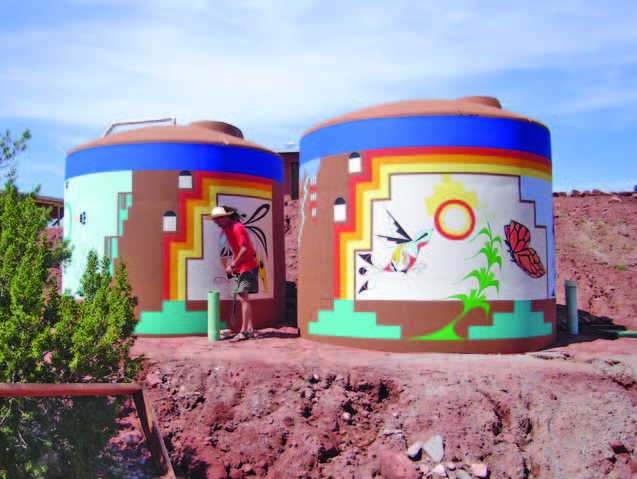The PermaDesign Weblog, with Nate Downey and Melissa McDonald!
Roof-Reliant Landscaping™ Step 17B: Elevation Options

You will need to determine in the early stages of your water harvesting system’s design whether your cistern will be aboveground, partially buried or underground. Here, are some of the advantages and disadvantages of each of these water-storage options.
An aboveground cistern is a water-storage tank situated on grade or on a concrete or gravel pad on or just above grade with no significant berming or excavation associated with the installation of the tank.

Advantages. For the majority of people, the most important benefit of an aboveground cistern is cost. The design, materials and installation costs of aboveground tanks are significantly lower than those of partially buried and underground alternatives. The most significant cost savings is due to the fact that relatively little work is needed to put aboveground cisterns in place. The relative ease of installation associated with aboveground waterstorage tanks is an important consideration, especially for the do-it-yourselfer. Aboveground cisterns range from very simple rain barrels to more complex gravity-fed systems. The simplest systems require only basic common sense, some “handyman” skills, a thorough reading of this and other similar texts and a permit (when required). Always check with the Construction Industry Division (505-476- 4700, www.rld.state.nm.us) and local governing bodies for details concerning specific requirements.

Another reason to choose an aboveground cistern is if you plan to water your roof-reliant landscape using gravity. Given the right terrain and landscape design, a properly elevated cistern and a hands-on owner can eliminate the use of a pump for both hose watering and drip irrigation. (For more information on this subject, see Chapter 10, Distribution.)
An aboveground cistern can provide wind protection, privacy, shade and even serve as an inspirational conversation piece. In addition, aboveground cistern systems can be easier to maintain than underground systems. Leaks are more easily spotted when they occur aboveground, and they can be repaired without any of the excavation often necessary when leaks occur underground.
Disadvantages. Many people fail to see the inherent “beauty” of a big, opaque, industriallooking aboveground cistern, so the potential costs of visual screening should not be overlooked. Screening a cistern can be accomplished least expensively by planting young trees, shrubs or trellised vines in front of your tank. Although they are more expensive, large trees, fencing, stucco walls and fine masonry make great screening options. Painting a mural on the tank is one way to increase the aesthetic appeal of an aboveground cistern. (See Figure Below.)

If you are successful at creating a roof-reliant landscape and your tank is well-hidden or attractively presented, it is quite possible that your property will increase in value. Certainly, homebuyers who appreciate beauty, comfort, convenience and water consciousness will consider a concealed above- ground cistern to be an important property asset.
Another important disadvantage of aboveground systems is that cisterns, pipes and pipe connections can freeze during the winter. This is a concern throughout the state of New Mexico. Be sure you know the frost depth for your area, and be sure to drain and/or insulate pipes so that no leaks occur.
If you must situate an aboveground cistern on the north side of a building in the northern part of the state where freezing temperatures are most likely to occur, you may wish to drain your tank before the first hard frost of winter. If you can place your aboveground cistern on the south side of your structure or if you live in southern New Mexico at a relatively low elevation, you may be able to store winter moisture with minimal fear of
discovering freeze-related leaks when temperatures warm up. One way to insulate an aboveground cistern is to berm it into the ground at a depth such that the outlet pipe from the side or bottom is below the frost line. (See next blog, Partially Buried Cisterns.)
Because plants often need supplemental moisture in the spring and early summer, storing water throughout the winter is extremely important for the roof-reliant landscaper. The disadvantages associated with ineffectively insulated aboveground cisterns and their fittings should be seriously weighed against the cost advantages that such cisterns provide. An inexpensive system that has to either be quickly drained in the middle of a cold winter night or repaired every spring is usually not worth the potential cost savings in the long term when compared to the price of a frostfree underground or partially buried cistern.
Aboveground cisterns also have the greatest tendency to harbor algae due to the intense New Mexico sunlight to which they are exposed. Be sure that the cistern you are using is opaque and UV resistant. Typically, darker colors are preferable to light colors in this regard.
Another disadvantage is the water in an aboveground cistern, especially a dark-colored cistern, can often get too hot to use on plants during certain times of day in the summer. Of course, watering should not be done during the hottest parts of the day to prevent evaporative loss (and because it is not allowed in many communities in New Mexico). Keep in mind, however, that the water in your cistern may remain too warm for landscape use well into the evening and sometimes into the nighttime hours, which leaves the morning as the best time to water from an aboveground cistern in the hot summer months.
02/11/2016 | (0) Comments










Comments